warning DODGE DART 2015 PF / 1.G Owner's Manual
[x] Cancel search | Manufacturer: DODGE, Model Year: 2015, Model line: DART, Model: DODGE DART 2015 PF / 1.GPages: 664, PDF Size: 16.96 MB
Page 66 of 664
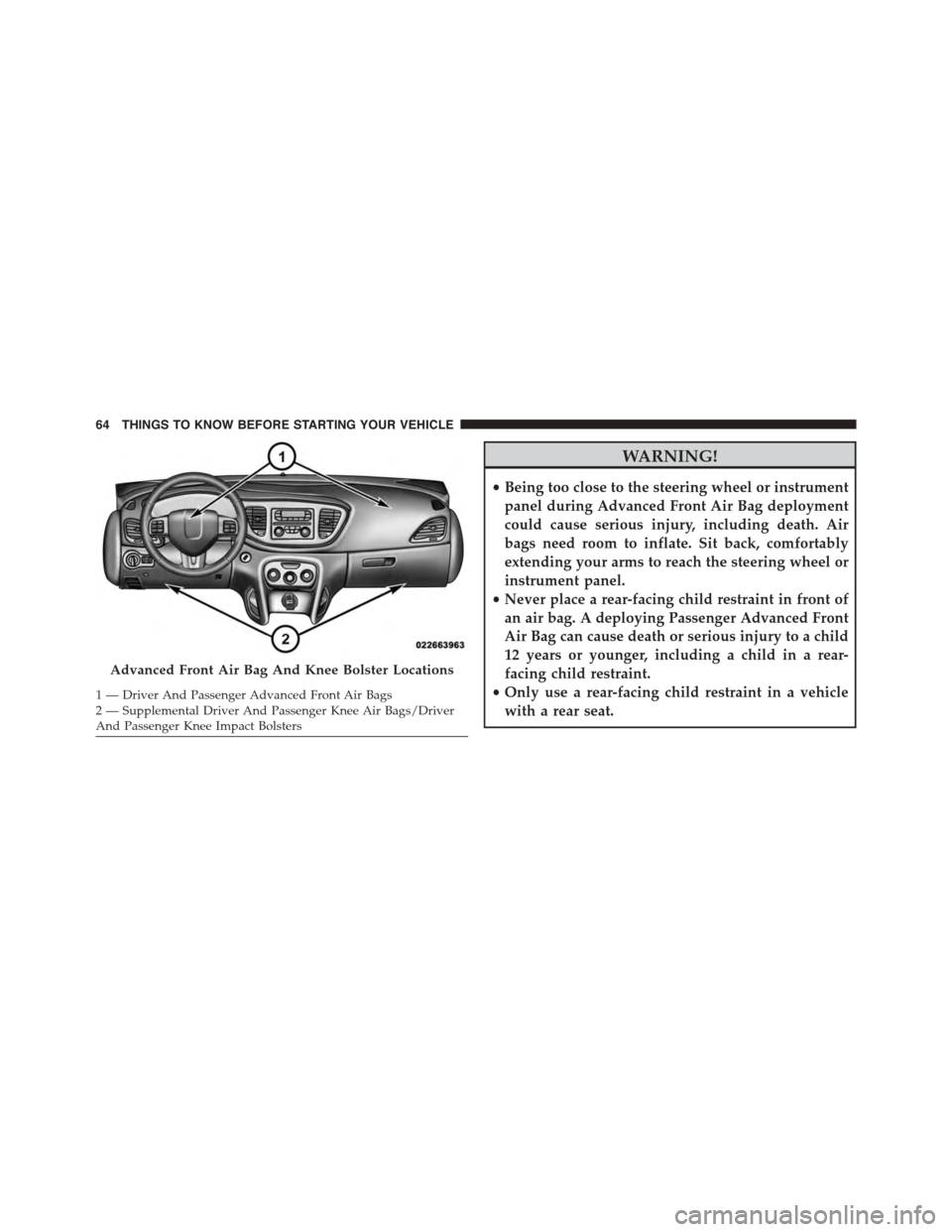
WARNING!
•Being too close to the steering wheel or instrument
panel during Advanced Front Air Bag deployment
could cause serious injury, including death. Air
bags need room to inflate. Sit back, comfortably
extending your arms to reach the steering wheel or
instrument panel.
•Never place a rear-facing child restraint in front of
an air bag. A deploying Passenger Advanced Front
Air Bag can cause death or serious injury to a child
12 years or younger, including a child in a rear-
facing child restraint.
•Only use a rear-facing child restraint in a vehicle
with a rear seat.
Advanced Front Air Bag And Knee Bolster Locations
1—DriverAndPassengerAdvancedFrontAirBags2—SupplementalDriverAndPassengerKneeAirBags/DriverAnd Passenger Knee Impact Bolsters
64 THINGS TO KNOW BEFORE STARTING YOUR VEHICLE
Page 67 of 664
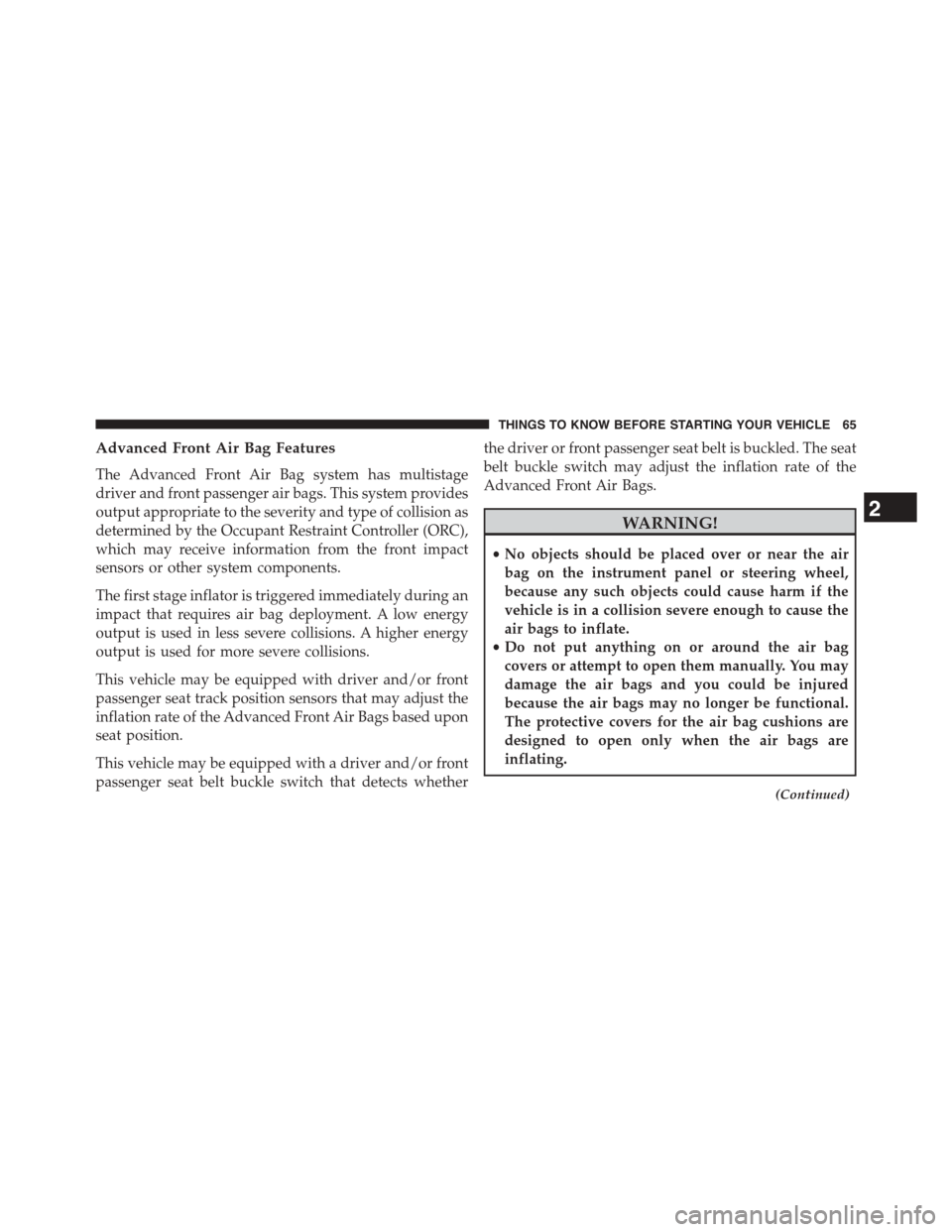
Advanced Front Air Bag Features
The Advanced Front Air Bag system has multistage
driver and front passenger air bags. This system provides
output appropriate to the severity and type of collision as
determined by the Occupant Restraint Controller (ORC),
which may receive information from the front impact
sensors or other system components.
The first stage inflator is triggered immediately during an
impact that requires air bag deployment. A low energy
output is used in less severe collisions. A higher energy
output is used for more severe collisions.
This vehicle may be equipped with driver and/or front
passenger seat track position sensors that may adjust the
inflation rate of the Advanced Front Air Bags based upon
seat position.
This vehicle may be equipped with a driver and/or front
passenger seat belt buckle switch that detects whether
the driver or front passenger seat belt is buckled. The seat
belt buckle switch may adjust the inflation rate of the
Advanced Front Air Bags.
WARNING!
•No objects should be placed over or near the air
bag on the instrument panel or steering wheel,
because any such objects could cause harm if the
vehicle is in a collision severe enough to cause the
air bags to inflate.
•Do not put anything on or around the air bag
covers or attempt to open them manually. You may
damage the air bags and you could be injured
because the air bags may no longer be functional.
The protective covers for the air bag cushions are
designed to open only when the air bags are
inflating.
(Continued)
2
THINGS TO KNOW BEFORE STARTING YOUR VEHICLE 65
Page 68 of 664
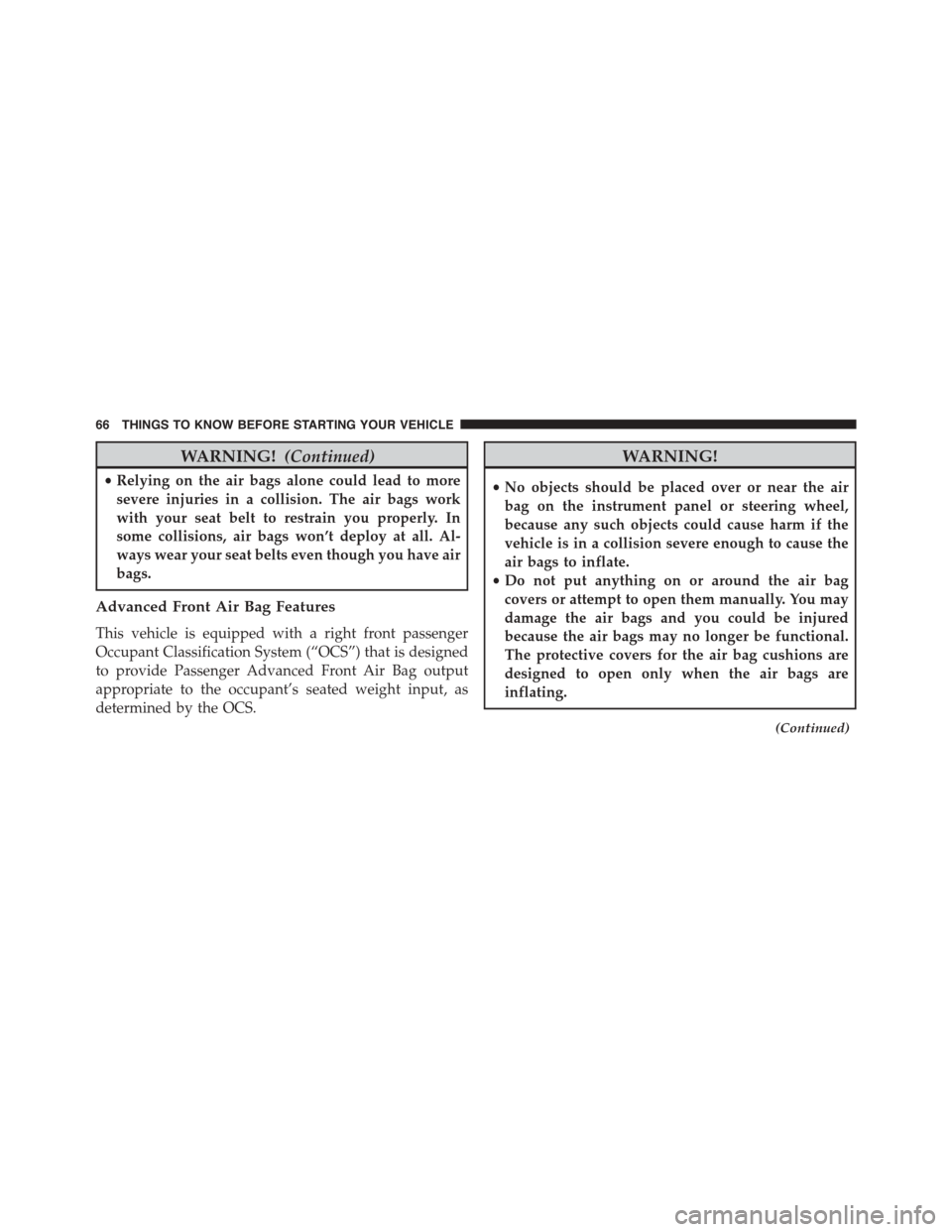
WARNING!(Continued)
•Relying on the air bags alone could lead to more
severe injuries in a collision. The air bags work
with your seat belt to restrain you properly. In
some collisions, air bags won’t deploy at all. Al-
ways wear your seat belts even though you have air
bags.
Advanced Front Air Bag Features
This vehicle is equipped with a right front passenger
Occupant Classification System (“OCS”) that is designed
to provide Passenger Advanced Front Air Bag output
appropriate to the occupant’s seated weight input, as
determined by the OCS.
WARNING!
•No objects should be placed over or near the air
bag on the instrument panel or steering wheel,
because any such objects could cause harm if the
vehicle is in a collision severe enough to cause the
air bags to inflate.
•Do not put anything on or around the air bag
covers or attempt to open them manually. You may
damage the air bags and you could be injured
because the air bags may no longer be functional.
The protective covers for the air bag cushions are
designed to open only when the air bags are
inflating.
(Continued)
66 THINGS TO KNOW BEFORE STARTING YOUR VEHICLE
Page 69 of 664
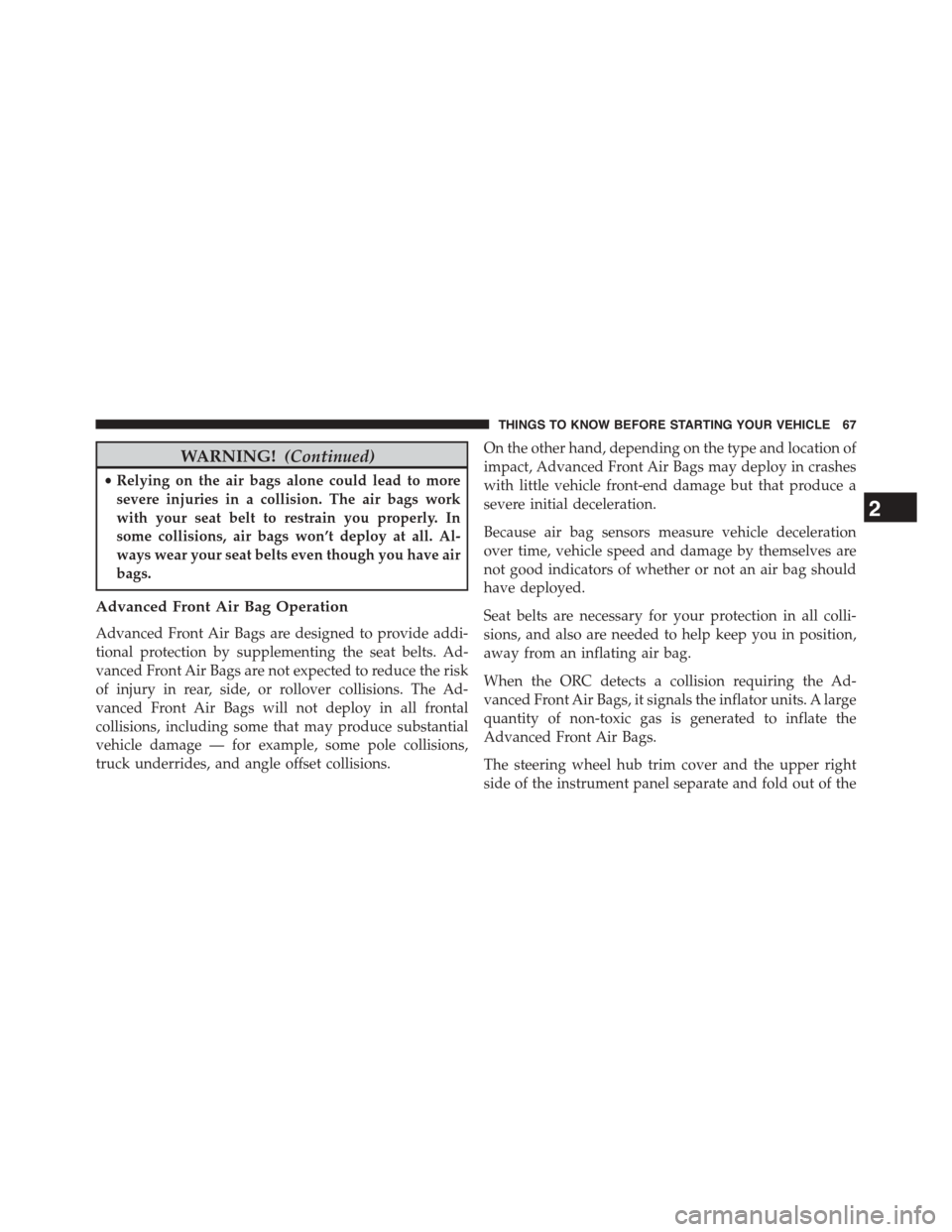
WARNING!(Continued)
•Relying on the air bags alone could lead to more
severe injuries in a collision. The air bags work
with your seat belt to restrain you properly. In
some collisions, air bags won’t deploy at all. Al-
ways wear your seat belts even though you have air
bags.
Advanced Front Air Bag Operation
Advanced Front Air Bags are designed to provide addi-
tional protection by supplementing the seat belts. Ad-
vanced Front Air Bags are not expected to reduce the risk
of injury in rear, side, or rollover collisions. The Ad-
vanced Front Air Bags will not deploy in all frontal
collisions, including some that may produce substantial
vehicle damage — for example, some pole collisions,
truck underrides, and angle offset collisions.
On the other hand, depending on the type and location of
impact, Advanced Front Air Bags may deploy in crashes
with little vehicle front-end damage but that produce a
severe initial deceleration.
Because air bag sensors measure vehicle deceleration
over time, vehicle speed and damage by themselves are
not good indicators of whether or not an air bag should
have deployed.
Seat belts are necessary for your protection in all colli-
sions, and also are needed to help keep you in position,
away from an inflating air bag.
When the ORC detects a collision requiring the Ad-
vanced Front Air Bags, it signals the inflator units. A large
quantity of non-toxic gas is generated to inflate the
Advanced Front Air Bags.
The steering wheel hub trim cover and the upper right
side of the instrument panel separate and fold out of the
2
THINGS TO KNOW BEFORE STARTING YOUR VEHICLE 67
Page 70 of 664
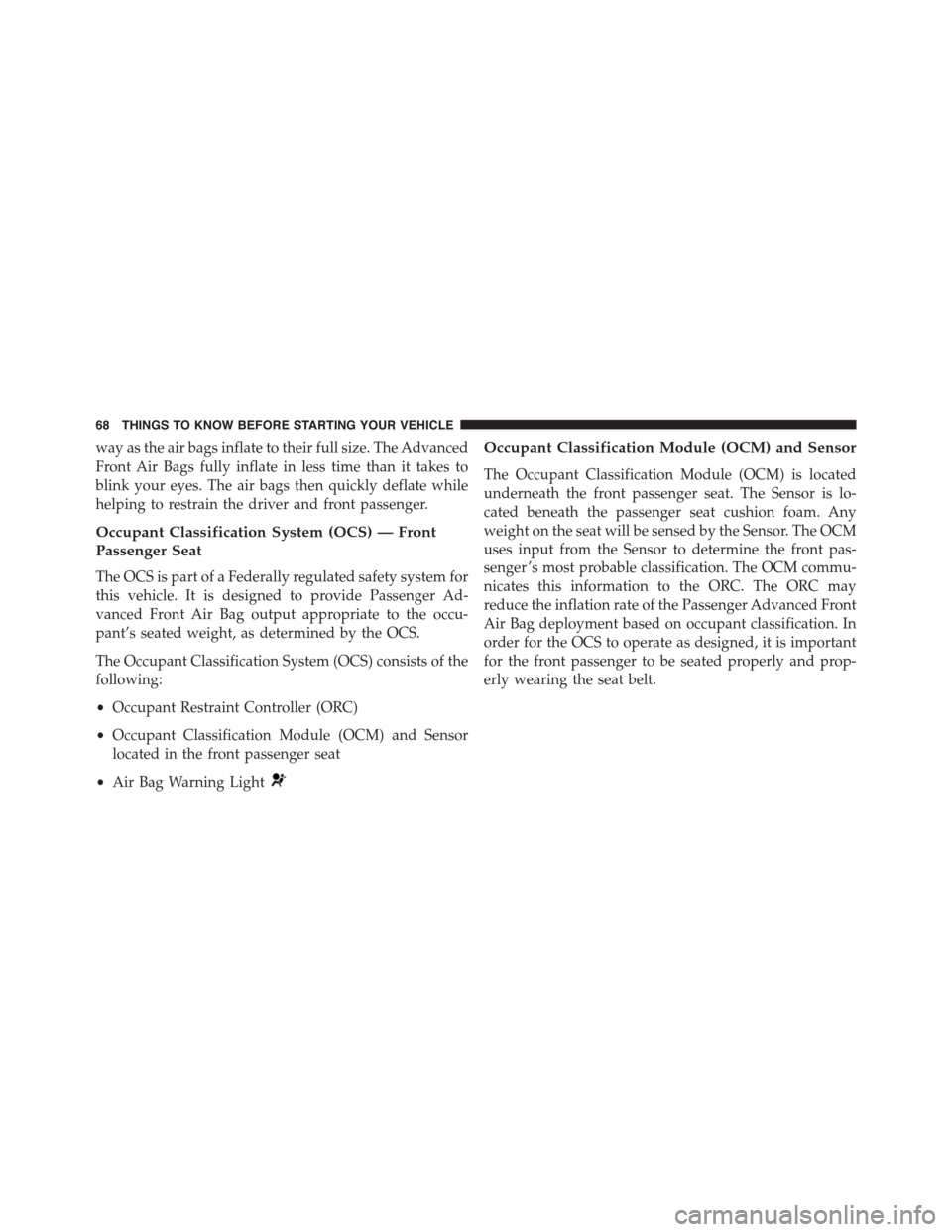
way as the air bags inflate to their full size. The Advanced
Front Air Bags fully inflate in less time than it takes to
blink your eyes. The air bags then quickly deflate while
helping to restrain the driver and front passenger.
Occupant Classification System (OCS) — Front
Passenger Seat
The OCS is part of a Federally regulated safety system for
this vehicle. It is designed to provide Passenger Ad-
vanced Front Air Bag output appropriate to the occu-
pant’s seated weight, as determined by the OCS.
The Occupant Classification System (OCS) consists of the
following:
•Occupant Restraint Controller (ORC)
•Occupant Classification Module (OCM) and Sensor
located in the front passenger seat
•Air Bag Warning Light
Occupant Classification Module (OCM) and Sensor
The Occupant Classification Module (OCM) is located
underneath the front passenger seat. The Sensor is lo-
cated beneath the passenger seat cushion foam. Any
weight on the seat will be sensed by the Sensor. The OCM
uses input from the Sensor to determine the front pas-
senger ’s most probable classification. The OCM commu-
nicates this information to the ORC. The ORC may
reduce the inflation rate of the Passenger Advanced Front
Air Bag deployment based on occupant classification. In
order for the OCS to operate as designed, it is important
for the front passenger to be seated properly and prop-
erly wearing the seat belt.
68 THINGS TO KNOW BEFORE STARTING YOUR VEHICLE
Page 72 of 664
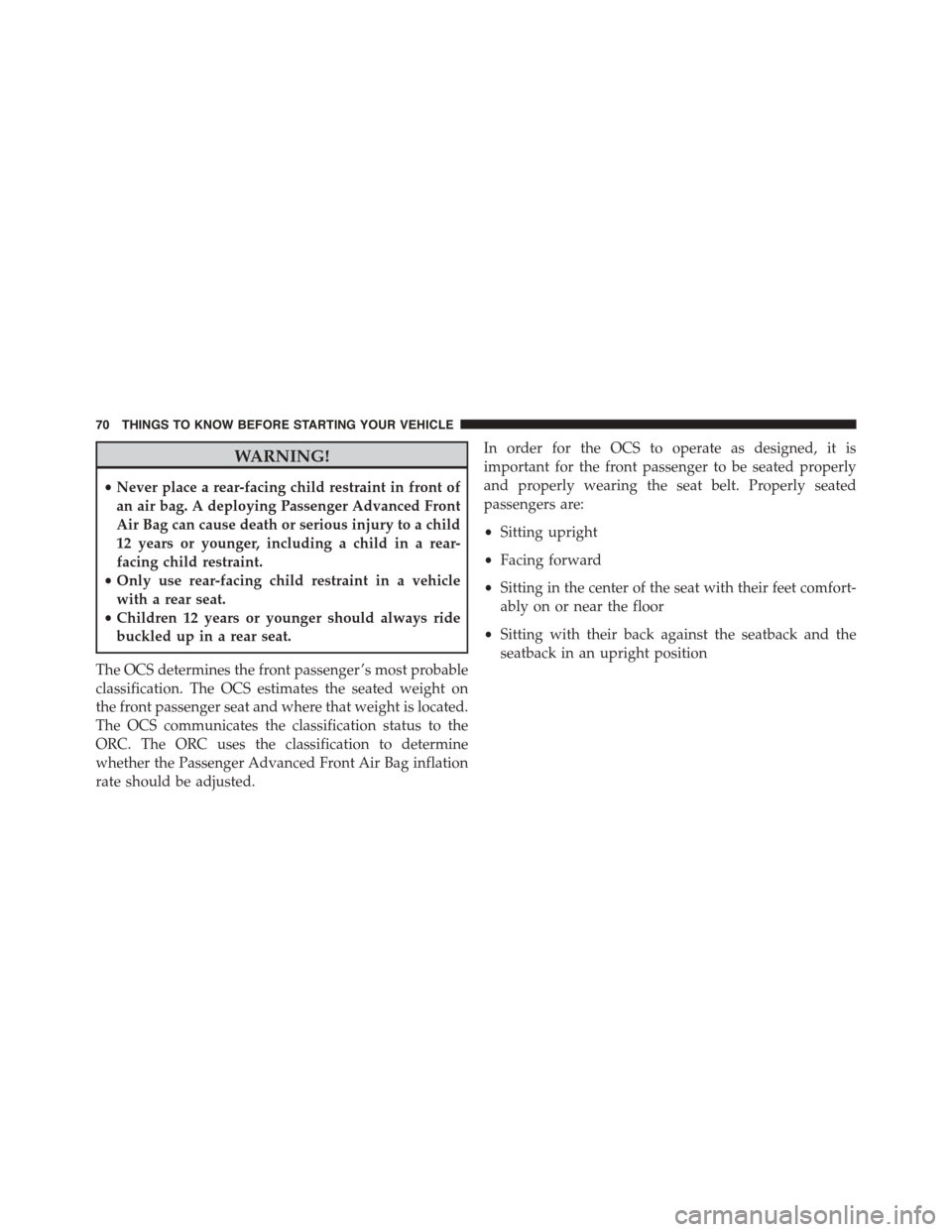
WARNING!
•Never place a rear-facing child restraint in front of
an air bag. A deploying Passenger Advanced Front
Air Bag can cause death or serious injury to a child
12 years or younger, including a child in a rear-
facing child restraint.
•Only use rear-facing child restraint in a vehicle
with a rear seat.
•Children 12 years or younger should always ride
buckled up in a rear seat.
The OCS determines the front passenger ’s most probable
classification. The OCS estimates the seated weight on
the front passenger seat and where that weight is located.
The OCS communicates the classification status to the
ORC. The ORC uses the classification to determine
whether the Passenger Advanced Front Air Bag inflation
rate should be adjusted.
In order for the OCS to operate as designed, it is
important for the front passenger to be seated properly
and properly wearing the seat belt. Properly seated
passengers are:
•Sitting upright
•Facing forward
•Sitting in the center of the seat with their feet comfort-
ably on or near the floor
•Sitting with their back against the seatback and the
seatback in an upright position
70 THINGS TO KNOW BEFORE STARTING YOUR VEHICLE
Page 77 of 664
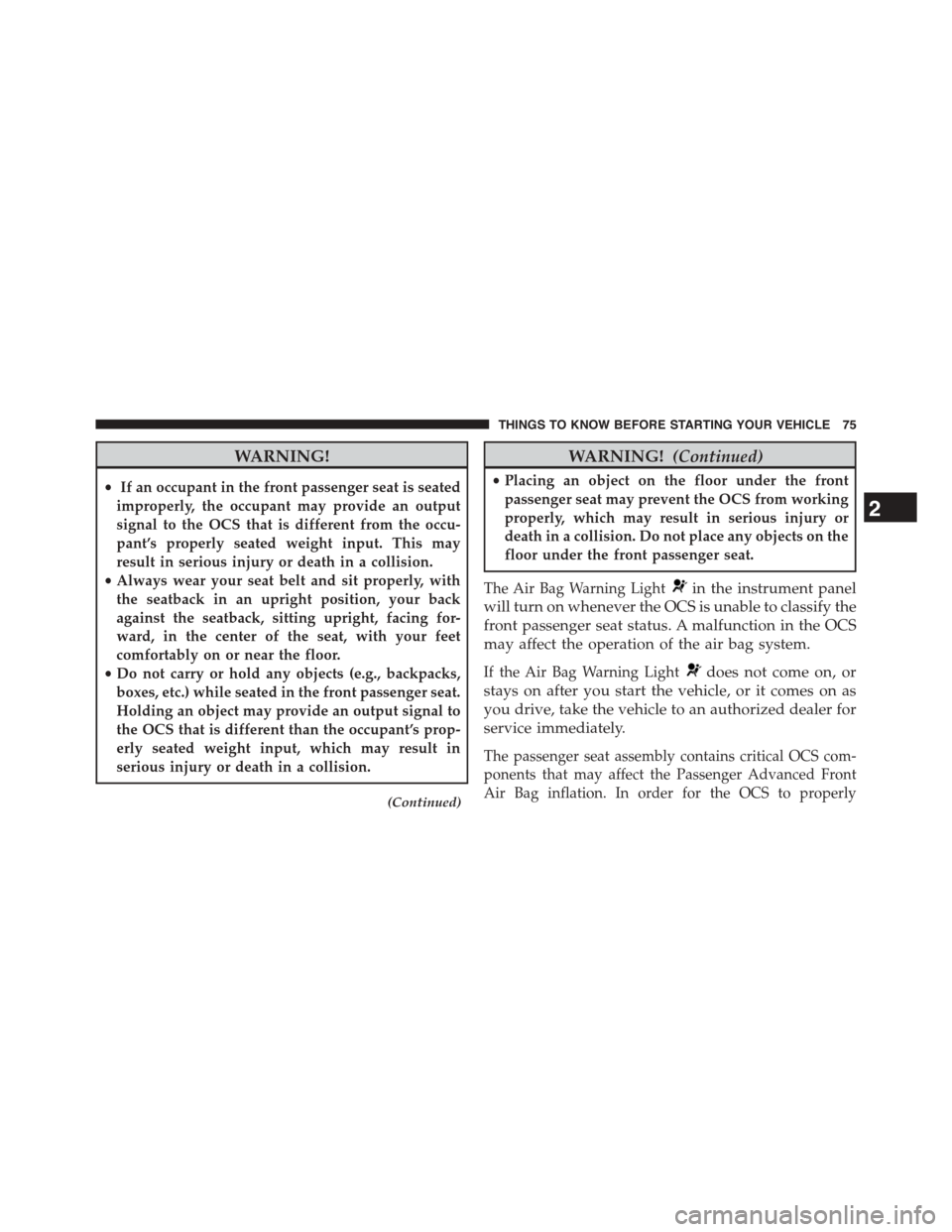
WARNING!
•If an occupant in the front passenger seat is seated
improperly, the occupant may provide an output
signal to the OCS that is different from the occu-
pant’s properly seated weight input. This may
result in serious injury or death in a collision.
•Always wear your seat belt and sit properly, with
the seatback in an upright position, your back
against the seatback, sitting upright, facing for-
ward, in the center of the seat, with your feet
comfortably on or near the floor.
•Do not carry or hold any objects (e.g., backpacks,
boxes, etc.) while seated in the front passenger seat.
Holding an object may provide an output signal to
the OCS that is different than the occupant’s prop-
erly seated weight input, which may result in
serious injury or death in a collision.
(Continued)
WARNING!(Continued)
•Placing an object on the floor under the front
passenger seat may prevent the OCS from working
properly, which may result in serious injury or
death in a collision. Do not place any objects on the
floor under the front passenger seat.
The Air Bag Warning Lightin the instrument panel
will turn on whenever the OCS is unable to classify the
front passenger seat status. A malfunction in the OCS
may affect the operation of the air bag system.
If the Air Bag Warning Lightdoes not come on, or
stays on after you start the vehicle, or it comes on as
you drive, take the vehicle to an authorized dealer for
service immediately.
The passenger seat assembly contains critical OCS com-
ponents that may affect the Passenger Advanced Front
Air Bag inflation. In order for the OCS to properly
2
THINGS TO KNOW BEFORE STARTING YOUR VEHICLE 75
Page 78 of 664
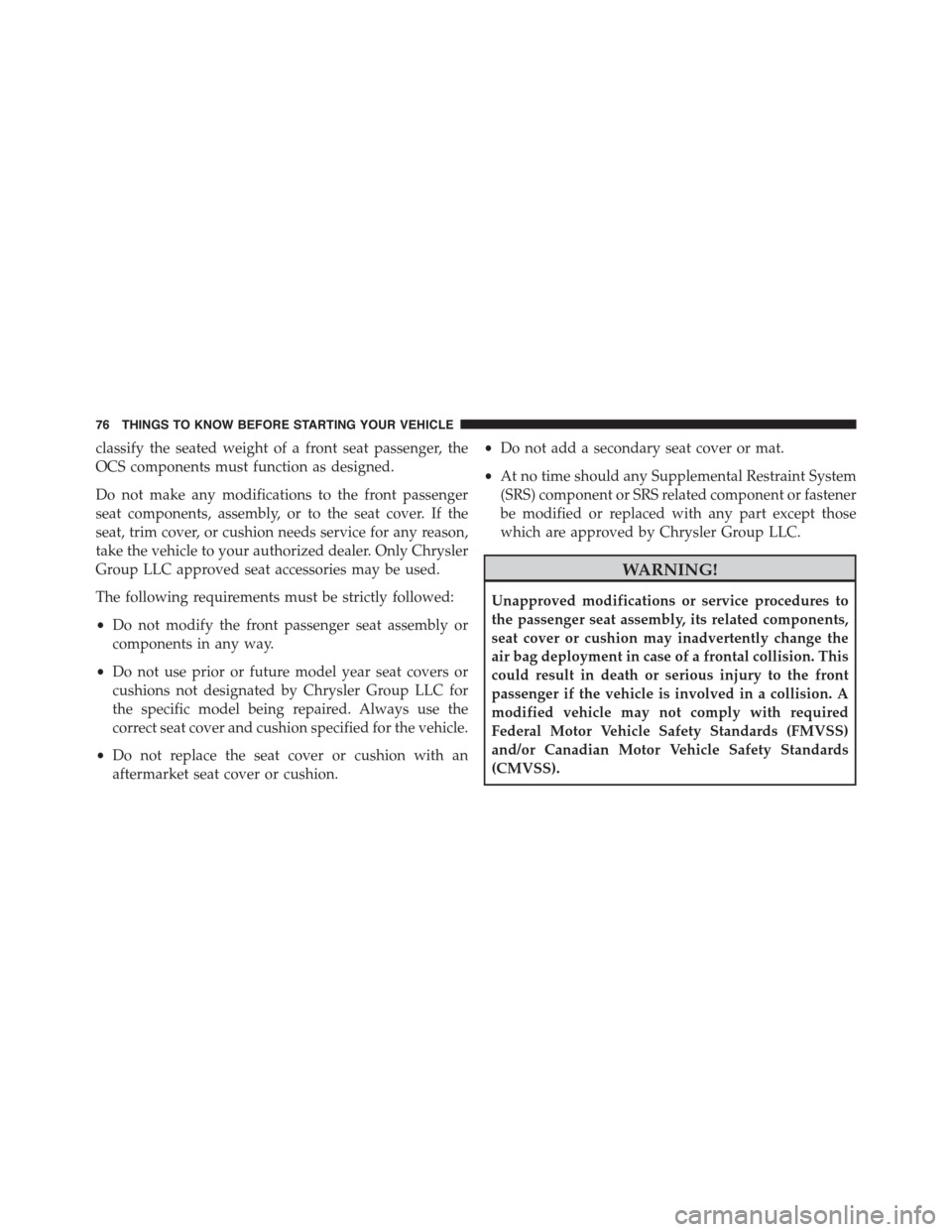
classify the seated weight of a front seat passenger, the
OCS components must function as designed.
Do not make any modifications to the front passenger
seat components, assembly, or to the seat cover. If the
seat, trim cover, or cushion needs service for any reason,
take the vehicle to your authorized dealer. Only Chrysler
Group LLC approved seat accessories may be used.
The following requirements must be strictly followed:
•Do not modify the front passenger seat assembly or
components in any way.
•Do not use prior or future model year seat covers or
cushions not designated by Chrysler Group LLC for
the specific model being repaired. Always use the
correct seat cover and cushion specified for the vehicle.
•Do not replace the seat cover or cushion with an
aftermarket seat cover or cushion.
•Do not add a secondary seat cover or mat.
•At no time should any Supplemental Restraint System
(SRS) component or SRS related component or fastener
be modified or replaced with any part except those
which are approved by Chrysler Group LLC.
WARNING!
Unapproved modifications or service procedures to
the passenger seat assembly, its related components,
seat cover or cushion may inadvertently change the
air bag deployment in case of a frontal collision. This
could result in death or serious injury to the front
passenger if the vehicle is involved in a collision. A
modified vehicle may not comply with required
Federal Motor Vehicle Safety Standards (FMVSS)
and/or Canadian Motor Vehicle Safety Standards
(CMVSS).
76 THINGS TO KNOW BEFORE STARTING YOUR VEHICLE
Page 79 of 664
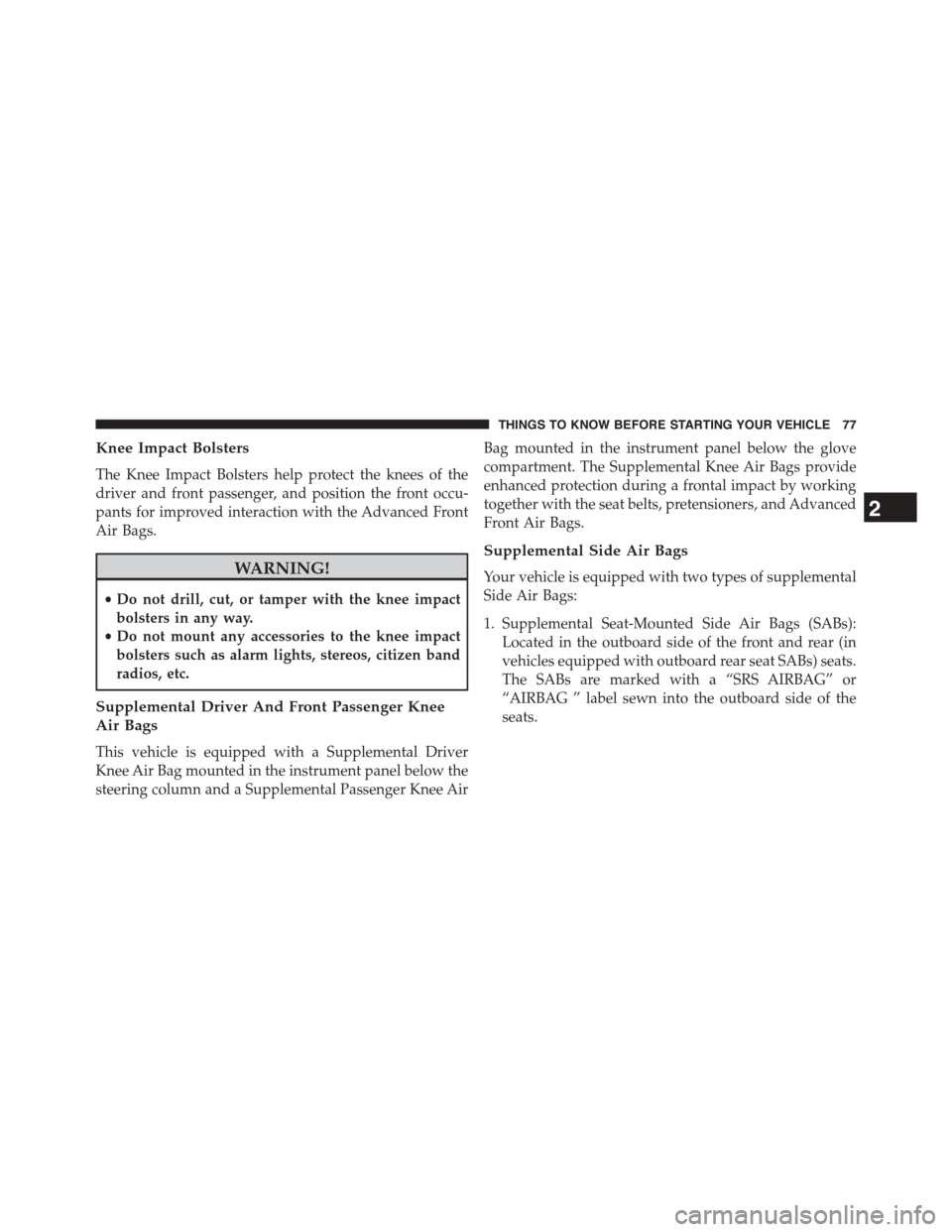
Knee Impact Bolsters
The Knee Impact Bolsters help protect the knees of the
driver and front passenger, and position the front occu-
pants for improved interaction with the Advanced Front
Air Bags.
WARNING!
•Do not drill, cut, or tamper with the knee impact
bolsters in any way.
•Do not mount any accessories to the knee impact
bolsters such as alarm lights, stereos, citizen band
radios, etc.
Supplemental Driver And Front Passenger Knee
Air Bags
This vehicle is equipped with a Supplemental Driver
Knee Air Bag mounted in the instrument panel below the
steering column and a Supplemental Passenger Knee Air
Bag mounted in the instrument panel below the glove
compartment. The Supplemental Knee Air Bags provide
enhanced protection during a frontal impact by working
together with the seat belts, pretensioners, and Advanced
Front Air Bags.
Supplemental Side Air Bags
Your vehicle is equipped with two types of supplemental
Side Air Bags:
1. Supplemental Seat-Mounted Side Air Bags (SABs):
Located in the outboard side of the front and rear (in
vehicles equipped with outboard rear seat SABs) seats.
The SABs are marked with a “SRS AIRBAG” or
“AIRBAG ” label sewn into the outboard side of the
seats.
2
THINGS TO KNOW BEFORE STARTING YOUR VEHICLE 77
Page 81 of 664
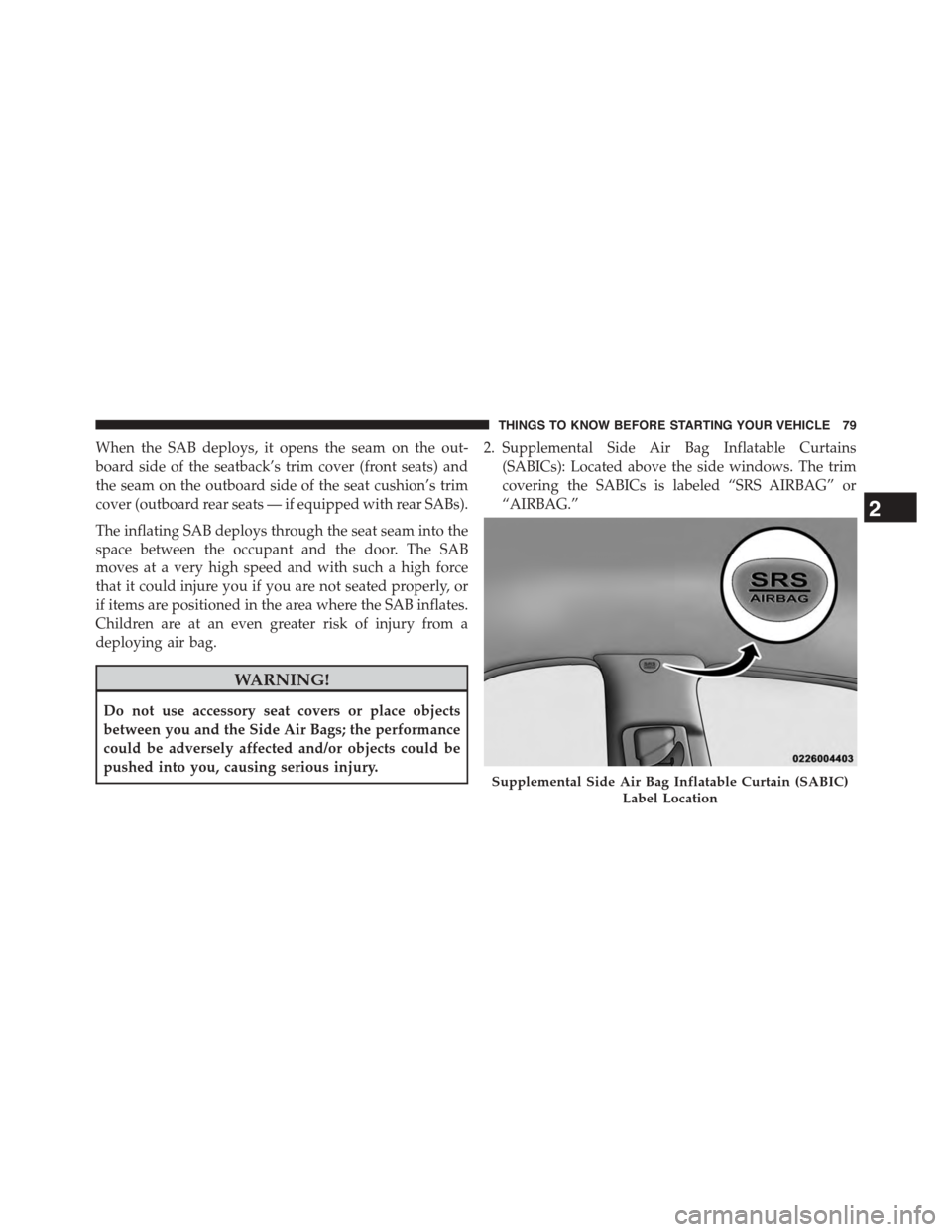
When the SAB deploys, it opens the seam on the out-
board side of the seatback’s trim cover (front seats) and
the seam on the outboard side of the seat cushion’s trim
cover (outboard rear seats — if equipped with rear SABs).
The inflating SAB deploys through the seat seam into the
space between the occupant and the door. The SAB
moves at a very high speed and with such a high force
that it could injure you if you are not seated properly, or
if items are positioned in the area where the SAB inflates.
Children are at an even greater risk of injury from a
deploying air bag.
WARNING!
Do not use accessory seat covers or place objects
between you and the Side Air Bags; the performance
could be adversely affected and/or objects could be
pushed into you, causing serious injury.
2. Supplemental Side Air Bag Inflatable Curtains
(SABICs): Located above the side windows. The trim
covering the SABICs is labeled “SRS AIRBAG” or
“AIRBAG.”
Supplemental Side Air Bag Inflatable Curtain (SABIC)
Label Location
2
THINGS TO KNOW BEFORE STARTING YOUR VEHICLE 79